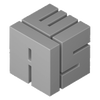How do you build complex shapes?
I’ve made a large number of custom prints, and all of them were created using TinkerCad. It’s an amazing toolkit, stupid easy to use but versatile. That is … until something needs a tiny adjustment somewhere. That’s when I feel it would’ve been neat to use parametric CAD instead.
I have spent many hours following Youtube tutorials for Onshape, Fusion, and FreeCAD. Tutorial shapes like a LEGO brick are fairly easy, although I admit that this kind of modeling is a sharp departure from the kid-friendly TinkerCad.
My problem is that I don’t want to make simple coasters or keychains, but complex shapes like this one. It’s a holder/mount for two different kinds of walkie-talkies that I use, and the blue part slides into a tray in my car’s dash where it sits nice and snug.
Question: How the hell do I even get started modeling something like this?? There’s not a single straight cuboid here. Everything is slightly wedge-shaped.
The way I do this in TinkerCad is that I build the hollow first: I made a 3d model of the walkie, a little oversized, set it be hollow, and drop it into the shape - that’s the red or orange shells you see.





Add comment